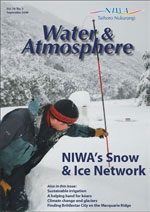PDF of this article (107 KB)




NIWA at Fieldays 2008
A major event in the farming calendar is Fieldays, held each June at Mystery Creek, Hamilton. The theme this year was the ‘Science of Farming’. NIWA’s stand showcased our work in environmental forecasting, climate analysis and forecasting, climate data, and finfish aquaculture.
Our focus was EcoConnect, our new environmental forecasting and climate information system. EcoConnect seamlessly provides information for a range of time and space scales: from the past (climate analysis), to the present (real-time observations), to accurate short-term forecasts of weather and weather-related impacts, to 15-day probabilistic outlooks of weather phenomena, right through to seasonal forecasts up to 3 months ahead.
We also showed visitors how they can access the National Climate Database via CliFlo.
For further information about EcoConnect and CliFlo, contact: Dr Michael Uddstrom, 0-4-386 0365, [email protected] www.niwa.co.nz/services/paid/ecoconnect and Errol Lewthwaite, 0-4-386 0472, [email protected] cliflo.niwa.co.nz
Aquaculture takes flight
Travellers passing through the Wellington airport domestic terminal in August and September were treated to a display of living examples of new developments in New Zealand’s aquaculture industry.
As part of a Science New Zealand exhibit showcasing the work of Crown Research Institutes in sustainable aquaculture development, NIWA stocked an aquarium with captive-bred paua and hapuku (groper).
The display highlighted NIWA’s success in developing culture techniques for paua, kingfish, and hapuku. Paua and hapuku are of high value to New Zealand’s aquaculture industry as food products that can be farmed for export. It is anticipated that these species will be at the forefront of aquaculture development which will take New Zealand to a billion dollar industry by 2025.
The animals in the aquarium were produced at NIWA’s Bream Bay Aquaculture Park in Northland using wild-caught broodstock.
For more information contact: Dr Michael Bruce, 0-9-375 4539, [email protected]
Kingfish selective breeding success
NIWA aquaculture scientists have achieved two important milestones in breeding kingfish for aquaculture: ‘closing’ the life cycle, and controlled paired matings.
Closing the life cycle in aquaculture means that you can complete the entire life cycle of a species, producing viable offspring that themselves breed in captivity. Scientists at NIWA’s Bream Bay Aquaculture Park in Ruakaka, Northland, have achieved this by breeding from captive kingfish that were themselves produced from eggs in captivity.
“This breakthrough means that kingfish rearing no longer depends on catching wild fish,” says Michael Bruce, Principal Scientist of the National Centre forFisheries & Aquaculture. We’ve also taken the next step towards fully controlling breeding by single paired matings, which means crossing a single male and female in captivity so that parentage of the resulting eggs is fully known. “This is not as straightforward as it sounds, and no-one knew if it would be possible with kingfish,” says Michael.
With these two breakthroughs, we can now establish kingfish family lines for our selective breeding programme. Our ultimate aim is to control kingfish pedigree, just as stock managers and breeders do with dairy herds and racehorses. “If we can produce offspring with predictable traits – such as good growth and feed utilisation, and disease resistance – we estimate we can improve performance by as much as 10–20% per generation,” says Michael.
Yellowtail kingfish are one of three high-value species – along with paua and hapuku (groper) – that NIWA is developing to support the New Zealand aquaculture industry’s aim of becoming a billion dollar business by 2025. We’ve invested significantly in acquiring broodstock and working outways to breed and rear these species in captivity. The selective breeding programme is supported by industry and funded to the tune of $4.6 millionby the Foundation for Research, Science and Technology.
For more information contact: Dr Michael Bruce, 0-9-375 4539, [email protected]
